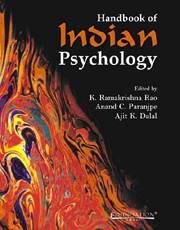Book contents
- Frontmatter
- Contents
- Contributing Authors
- Preface
- 01 Prologue: Introducing Indian Psychology
- 02 Indian Thought and Tradition: A Psychohistorical Perspective
- PART I SYSTEMS AND SCHOOLS
- PART II TOPICS AND THEMES
- PART III APPLICATIONS AND IMPLICATIONS
- 24 Therapeutic Psychology and Indian Yoga
- 25 Towards an Indian Organizational Psychology
- 26 Research on Indian Concepts of Psychology: Major Challenges and Perspectives for Future Action
- 27 Meditative Traditions and Contemporary Psychology
- 28 Consciousness Evolution of the Buddha until He Attained Satori
- 29 William James on Pure Experience and Samādhi in Sāṃkhya Yoga
- 30 Sri Ramaṇa Maharshi: A Case Study in Self-Realization
- 31 Altered States of Consciousness and the Spiritual Traditions: The Proposal for the Creation of State-Specific Sciences
- Pronunciation and Transliteration of Sanskrit Alphabet
- Glossary
- Index
30 - Sri Ramaṇa Maharshi: A Case Study in Self-Realization
from PART III - APPLICATIONS AND IMPLICATIONS
Published online by Cambridge University Press: 26 October 2011
- Frontmatter
- Contents
- Contributing Authors
- Preface
- 01 Prologue: Introducing Indian Psychology
- 02 Indian Thought and Tradition: A Psychohistorical Perspective
- PART I SYSTEMS AND SCHOOLS
- PART II TOPICS AND THEMES
- PART III APPLICATIONS AND IMPLICATIONS
- 24 Therapeutic Psychology and Indian Yoga
- 25 Towards an Indian Organizational Psychology
- 26 Research on Indian Concepts of Psychology: Major Challenges and Perspectives for Future Action
- 27 Meditative Traditions and Contemporary Psychology
- 28 Consciousness Evolution of the Buddha until He Attained Satori
- 29 William James on Pure Experience and Samādhi in Sāṃkhya Yoga
- 30 Sri Ramaṇa Maharshi: A Case Study in Self-Realization
- 31 Altered States of Consciousness and the Spiritual Traditions: The Proposal for the Creation of State-Specific Sciences
- Pronunciation and Transliteration of Sanskrit Alphabet
- Glossary
- Index
Summary
The purpose of this essay is to present a case study illustrating the attainment of self-realization in the life of a modern sage, Sri Ramaṇa Maharshi (1879–1950). To that end, the author shall briefly sketch the life history and teachings of Sri Ramaṇa Maharshi, whose approach is widely recognized as very closely following the Advaitic model of Self-realization in Śaṅkara's tradition. Insofar as the principles of Advaita are described in Paranjpe and Rao's chapter titled Psychology in the Advaita Vedānta in this Handbook, this chapter is expected to complement it by providing a concrete instance of how those principles may manifest in real life. It is hoped that the discussion here will show how Advaita Vedānta is not simply an abstract system of philosophy involving idle speculation, but a practical philosophy of life, involving a form of applied psychology that can effectively guide a person's self-realization.
I would like to clarify at the outset that the approach to case study adopted here is inspired by Erik Erikson's (1962; 1969) psycho-historical studies of the biographies of Martin Luther and Mahatma Gandhi, but with a difference. The main difference is that, while Erikson uses his extension of the Freudian model to examine life histories portrayed in biographical sources, I have tried to examine the life history of Sri Ramaṇa primarily, although not exclusively, in light of his own teachings. Given the background of the Eriksonian approach that inspired this study, the relevance of Erikson's theory of identity formation is crucial here. For, as I have tried to show elsewhere (Paranjpe, 1998), there is a good deal of complementarity between Eriksonian view of the search for identity and the Advaitc view of self-realization.
- Type
- Chapter
- Information
- Handbook of Indian Psychology , pp. 564 - 576Publisher: Foundation BooksPrint publication year: 2008
- 3
- Cited by



